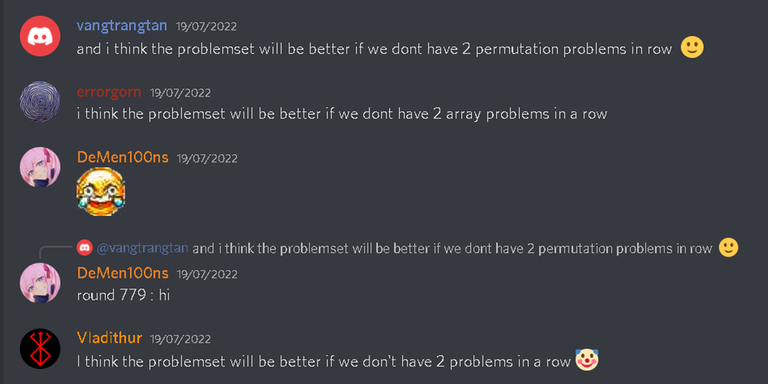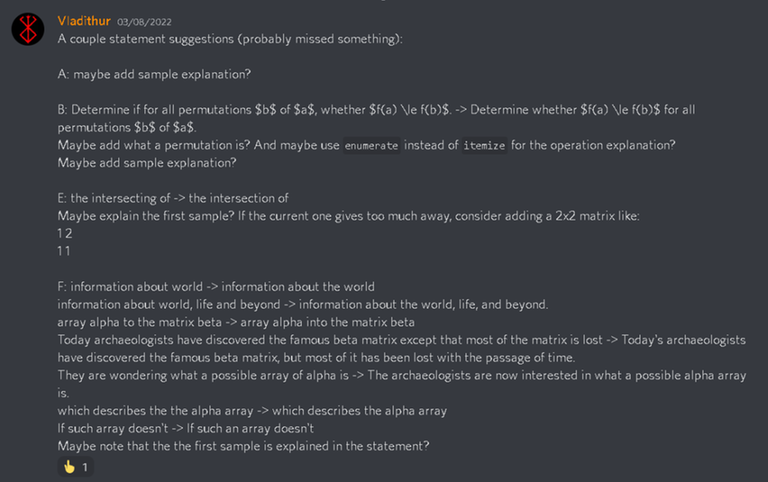Great efforts have been put over last year. We want to say thanks to everybody who helped us to make this round as it is. Cannot wait to see you guys on the next one!
| Tester | A | B | C | D | E | F |
|---|---|---|---|---|---|---|
| tfg | 800 | 1500 | 1600 | 1900 | 2100 | 2400 |
| neko_nyaaaaaaaaaaaaaaaaa | 800 | 1100 | 1700 | 1900 | 2100 | 2600 |
| BucketPotato | 800 | 1100 | 1700 | 1900 | 2100 | 2600 |
| LetterC67 | 800 | 1200 | 1400 | 1600 | 2100 | - |
| _FireGhost_ | 800 | 1100 | 1500 | 1900 | 2000 | 2400 |
| fextivity | 800 | 1000 | 1400 | 1700 | 2000 | 2400 |
| generic_placeholder_name | 800 | 1100 | 1600 | 1900 | 2200 | - |












1713A - Traveling Salesman Problem
Do we actually need to go off the axis?
How to avoid visiting an axis more than once?
1713A - Traveling Salesman Problem
To collect the furthest boxes on $$$Ox+$$$, we need to go in the following order: $$$(0, 0), (x_{max}, 0), (0, 0)$$$. Surprisingly, every other boxes on the $$$Ox+$$$ axis can be collected on the way. So the minimum number of moves required is $$$2 \cdot (|x_{max}|)$$$. The same strategy can also be applied on $$$Ox-$$$, $$$Oy+$$$ and $$$Oy-$$$. Just be careful when there is at least one axis that does not contain any boxes.
Time complexity: $$$O(n)$$$
def solve():
n = int(input())
minX, minY, maxX, maxY = 0, 0, 0, 0
for i in range(n):
x, y = list(map(int, input().split()))
minX = min(x, minX)
maxX = max(x, maxX)
minY = min(y, minY)
maxY = max(y, maxY)
print(2 * (maxX + maxY - minX - minY))
test = int(input())
while test > 0:
test -= 1
solve()
How to calculate $$$f(a)$$$?
What if $$$a$$$ is intially sorted?
Consider $$$a$$$ has $$$3$$$ elements. What if $$$a_1 \geq a_2 \leq a_3$$$?
1713A - Traveling Salesman Problem
Let's define $$$max([l, r])$$$ the integer that has the maximum value over $$$a_l, a_{l+1}, \dots, a_r$$$, and $$$g(a)$$$ the the minimum value of $$$f(p)$$$ over all permutation $$$p$$$ of $$$a$$$.
First of all, we want to construct any permutation $$$p$$$ of $$$a$$$ such that $$$f(p) = g(a)$$$. One way to do so is making the array $$$a$$$ sorted in non-decreasing order. Then for each operation, we find the left most element $$$a_l$$$ of $$$p$$$ such that $$$a_l \neq 0$$$, then decrease all the elements $$$p_l, p_{l+1}, \dots, p_n$$$ by $$$1$$$. This cost exactly $$$max([1, n])$$$ operations. It can be proved that there is no other permutation of $$$a$$$ which produces less operations than when it is sorted.
Now consider $$$3$$$ indexes $$$i$$$, $$$j$$$ and $$$k$$$ of the array ($$$1 \le i < j < k \le n$$$). We want to make all $$$a_i$$$, $$$a_j$$$ and $$$a_k$$$ equal to $$$0$$$ in some operations. There are $$$2$$$ cases: - $$$a_i > a_j$$$ and $$$a_j < a_k$$$: this cost $$$a_i + a_k - a_j$$$ operations. - Other cases cost the same number of operations: $$$max(a_i, a_j, a_k)$$$.
Since we have proved $$$g(a) = max([1, n])$$$, then if the second cases are true for every indexes $$$i$$$, $$$j$$$ and $$$k$$$, $$$a$$$ is optimal. But in the first case cost $$$a_i + a_k - a_j = max(a_i, a_k) + min(a_i, a_k) - a_j$$$ operations. Because
Unable to parse markup [type=CF_MATHJAX]
and $$$(min(a_i, a_k) - a_j) > 0$$$, then $$$a_i + a_k - a_j > max(a_i, a_j, a_k)$$$ which requires more operations than the optimal one.The prove is done. The answer is \tttext{"NO"} if there exists an index $$$i$$$ ($$$2 \le i \le n - 1$$$) such that $$$max([1, i-1]) > a_i$$$ and $$$a_i < max([i+1, n])$$$. Otherwise, the answer is \tttext{"YES"}. Note that $$$max([1, r])$$$ and $$$max([l, n])$$$ can be precalculated by using an prefix max and an suffix max array.
Time complexity: $$$O(n)$$$
#include <bits/stdc++.h>
using namespace std;
const int N = 1e5 + 5;
int n, a[N], pref[N], suff[N];
int main() {
int tc; cin >> tc;
while (tc--) {
cin >> n;
for (int i = 1; i <= n; i++)
cin >> a[i];
pref[1] = a[1];
for (int i = 2; i <= n; i++)
pref[i] = max(pref[i-1], a[i]);
suff[n] = a[n];
for (int i = n - 1; i >= 1; i--)
suff[i] = max(suff[i+1], a[i]);
bool ok = true;
for (int i = 2; i <= n - 1; i++) {
if (pref[i-1] > a[i] && a[i] < suff[i+1]) {
ok = false;
}
}
cout << (ok ? "YES\n" : "NO\n");
}
}
Is there any case that the answer doesn't exist?
What if: $$$n \le 5$$$
Construct the suffix instead of the prefix.
With any positive integer $$$x$$$, there is at least one square number in $$$[x, 2x]$$$.
1713C - Build Permutation
First, let's prove that the answer always exists. Let's call the smallest square number that is not smaller than $$$k$$$ is $$$h$$$. Therefore $$$h \leq 2 \cdot k$$$, which means $$$h - k \leq k$$$.
So we can fill $$$p_i = h - i$$$ for $$$(h - k \leq i \leq k)$$$. Using this method we can recursively reduce $$$k$$$ to $$$h - k - 1$$$, then all the way down to $$$-1$$$.
We can prove that $$$h - k \geq 0$$$, as $$$h \geq k$$$.
Time complexity: $$$O(n)$$$
#include <bits/stdc++.h>
using namespace std;
const int N = 1e5 + 5;
int n, ans[N];
void recurse(int r) {
if (r < 0) return;
int s = sqrt(2*r); s *= s;
int l = s - r; recurse(l - 1);
for (; l <= r; l++, r--) {
ans[l] = r; ans[r] = l;
}
}
int main() {
int tc; cin >> tc;
while (tc--) {
cin >> n; recurse(n - 1);
for (int i = 0; i < n; i++)
cout << ans[i] << ' ';
cout << '\n';
}
}
We made sure that almost every $$$2^{n - 1}$$$ solutions cannot pass.
Did you use the $$$0$$$ query?
$$$\frac{2^{n + 1}}{3} = 2^n \cdot \frac{2}{3}$$$, what is the conclusion?
1713D - Tournament Coundown
There is a way to erase $$$3$$$ participants in every $$$2$$$ queries. Since there are $$$2^n - 1$$$ participants to be removed, the number of queries will be $$$\left \lceil (2^n - 1) \cdot \frac{2}{3} \right \rceil = \left \lfloor \frac{2^{n + 1}}{3} \right \rfloor$$$. Suppose there are only $$$4$$$ participants. In the first query we will ask the judge to compare the $$$1^{st}$$$ and the $$$3^{rd}$$$ participants. There are three cases:
The $$$1^{st}$$$ participant wins more game than the $$$3^{rd}$$$ one: the $$$2^{nd}$$$ and $$$3^{rd}$$$ cannot be the winner.
The $$$3^{rd}$$$ participant wins more game than the $$$1^{st}$$$ one: the $$$1^{st}$$$ and $$$4^{th}$$$ cannot be the winner.
The $$$1^{st}$$$ and $$$3^{rd}$$$ participants' numbers of winning games are equal: both the $$$1^{st}$$$ and $$$3^{rd}$$$ cannot be the winner.
Ask the remaining two participants, find the winner between them.
If there are more than $$$4$$$ participants, we can continuously divide the number by $$$4$$$ again and again, until there are at most $$$2$$$ participants left. Now we can get the winner in one final query.
#include <bits/stdc++.h>
using namespace std;
int ask(vector<int> &k)
{
cout << "? " << k[0] << ' ' << k[2] << endl;
int x;
cin >> x;
if (x == 1)
{
cout << "? " << k[0] << ' ' << k[3] << endl;
cin >> x;
if (x == 1) return k[0];
return k[3];
}
else if (x == 2)
{
cout << "? " << k[1] << ' ' << k[2] << endl;
cin >> x;
if (x == 1) return k[1];
return k[2];
}
else
{
cout << "? " << k[1] << ' ' << k[3] << endl;
cin >> x;
if (x == 1) return k[1];
return k[3];
}
}
void solve()
{
int n;
cin >> n;
vector<int> a, b;
for (int i = 1; i <= (1LL << n); i++)
{
a.push_back(i);
}
while (a.size() > 2)
{
while (!a.empty())
{
vector<int> k(4);
k[0] = a.back();
a.pop_back();
k[1] = a.back();
a.pop_back();
k[2] = a.back();
a.pop_back();
k[3] = a.back();
a.pop_back();
int win = ask(k);
b.push_back(win);
}
a = b;
b.clear();
}
if (a.size() == 2)
{
cout << "? " << a[0] << ' ' << a[1] << endl;
int x;
cin >> x;
if (x == 2) a[0] = a[1];
}
cout << "! " << a[0] << endl;
}
int main(int argc, char ** argv)
{
int tests;
cin >> tests;
while(tests--) solve();
}
This is not a greedy problem.
Think of the most to the least significant cell of the matrix.
How many positions in the matrix can a cell travel to after performing the operations?
And for each position that that cell can travel to, how many ways are there we can make it?
1713E - Cross Swapping
Let's take a look at what the lexicographically smallest matrix is. Let's call $$$(x, y)$$$ a cell that is in the intersection of row $$$x$$$ and column $$$y$$$ of the matrix, and the integer written on that cell is $$$A_{x, y}$$$. A cell $$$(x_p, y_p)$$$ of this matrix is called more significant than the another cell $$$(x_q, y_q)$$$ if and only if $$$x_p < x_q$$$, or $$$x_p = x_q$$$ and $$$y_p < y_q$$$. The problem asks us to find the smallest matrix so the best suitable way to solve this problem is to traverse through the most to the least significant cell of the matrix, then determine if the current cell can be minimized or not.
Suppose the current cell we are looking at is $$$(x, y)$$$. If $$$x = y$$$ then its position will not change after performing the operations. But if $$$x \neq y$$$, there are exactly $$$2$$$ operations that swap $$$(x, y)$$$ with another cell, that is $$$k = x$$$ and $$$k = y$$$. Both of these operations swap $$$(x, y)$$$ with the same cell $$$(y, x)$$$. So the only way we can minimize the value of $$$(x, y)$$$ is to try swapping it with $$$(y, x)$$$ (if $$$x < y$$$ and $$$A_{x, y} > A_{y, x}$$$) in some way.
As a result we have our constructive algorithm. Remind that for each operation $$$k = i$$$ of the matrix ($$$1 \le i \le n$$$), there are $$$2$$$ states: it is being performed and not being performed. Suppose we have traversed to the cell $$$(x, y)$$$. If $$$x \ge y$$$, ignore it. If $$$x < y$$$ then we try to make $$$A_{x, y} = min(A_{x, y}, A_{y, x})$$$ by deciding to swap or not to swap the cells. If $$$A_{x, y} > A_{y, x}$$$, try to swap $$$(x, y)$$$ with $$$(y, x)$$$ by making $$$2$$$ operations $$$k = x$$$ and $$$k = y$$$ having different states. And if $$$A_{x, y} < A_{y, x}$$$ then we should keep their positions unchanged by making $$$2$$$ operations $$$k = x$$$ and $$$k = y$$$ having the same state. Note that if $$$A_{x, y} = A_{y, x}$$$, we do nothing.
Let's implement this algorithm using a simple DSU where the $$$ith$$$ node represents the operation $$$k = i$$$. We define the value $$$par[u]$$$ in such a way that, suppose $$$p$$$ is the root of the $$$u$$$ node's component, $$$par[u] = p$$$ if $$$2$$$ operations $$$k = u$$$ and $$$k = p$$$ should have the same state, or $$$par[u] = -p$$$ if $$$2$$$ operations $$$k = u$$$ and $$$k = p$$$ should have different states. Define another function $$$join(i, j)$$$ to union $$$2$$$ nodes $$$i$$$ and $$$j$$$ to the same component. Note that $$$u$$$ and $$$-u$$$ are always in the same component and $$$par[-u] = -par[u]$$$. Thus, for the current cell $$$(x, y)$$$, we want to swap it with $$$(y, x)$$$ by calling $$$join(x, -y)$$$, or keep its position unchanged by calling $$$join(x, y)$$$.
After constructing the graphs, the last thing to do is to determine which operations should be performed. One way to do so is for each root of the components of the DSU, we perform the operation which this root represents for. Then for other nodes just check $$$par[i] > 0$$$ for the $$$ith$$$ node and if it is true, the $$$k = i$$$ operation should be performed. When we have the list of the operations that need to be performed, we can bruteforcely perform all the operations one by one and the final matrix will be the lexicographically smallest matrix.
Time complexity: $$$O(n^2)$$$
#include <bits/stdc++.h>
using namespace std;
const int N = 2e3 + 5;
int n, a[N][N];
int par[N];
int getPar(int u) {
if (u < 0) return -getPar(-u);
if (u == par[u]) return u;
return par[u] = getPar(par[u]);
}
void join(int u, int v) {
u = getPar(u); v = getPar(v);
if (abs(u) != abs(v)) {
if (u > 0) par[u] = v;
else par[-u] = -v;
}
}
int main() {
cin.tie(nullptr) -> sync_with_stdio(false);
int tc; cin >> tc;
while (tc--) {
cin >> n;
for (int i = 1; i <= n; i++)
for (int j = 1; j <= n; j++) {
cin >> a[i][j];
}
iota(par + 1, par + n + 1, 1);
// set par[i] == i for i in [1, n]
for (int i = 1; i <= n; i++)
for (int j = 1; j <= n; j++) {
if (a[i][j] < a[j][i]) join(i, j);
if (a[i][j] > a[j][i]) join(i, -j);
}
for (int i = 1; i <= n; i++) {
if (getPar(i) < 0) continue;
// we only perform the operation
// if and only if getPar(i) > 0
for (int j = 1; j <= n; j++)
swap(a[i][j], a[j][i]);
}
for (int i = 1; i <= n; i++) {
for (int j = 1; j <= n; j++) {
cout << a[i][j] << ' ';
}
cout << '\n';
}
}
}
- Is there any case that the answer doesn't exist?
- If exist, are there multiple?
- How many times does $$$a_i$$$ contribute to $$$b_{j, n}$$$?
$$$\rightarrow$$$ Calculate value that $$$a_i$$$ contribute to $$$b_{j, n}$$$.
Consider the inverse problem: Given array $$$a$$$. Construct $$$b_{j, n}$$$ for all $$$j$$$. How can you solve this problem?
Consider easier problem: Let construct matrix $$$g$$$ of size $$$(2n + 1) \times (n + 1)$$$ same way as matrix $$$b$$$. Given $$$g_{i, n}$$$ $$$(1 \le i \le 2n)$$$, please reconstruct $$$a$$$. How can you solve this problem?
1713F - Lost Array
Tutorial and solution for this problem will be updated later.





